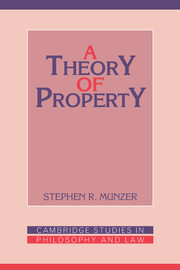Book contents
- Frontmatter
- Contents
- Preface and acknowledgments
- 1 Property, justification, and evaluation
- Part I Property rights and personal rights
- Part II From individuals to social context
- Part III Justification and distributive equity
- 8 Utility and efficiency
- 9 Justice and equality
- 10 Labor and desert
- 11 Conflict and resolution
- Part IV Applications
- Table of cases
- Index of names
- Index of subjects
10 - Labor and desert
Published online by Cambridge University Press: 05 June 2012
- Frontmatter
- Contents
- Preface and acknowledgments
- 1 Property, justification, and evaluation
- Part I Property rights and personal rights
- Part II From individuals to social context
- Part III Justification and distributive equity
- 8 Utility and efficiency
- 9 Justice and equality
- 10 Labor and desert
- 11 Conflict and resolution
- Part IV Applications
- Table of cases
- Index of names
- Index of subjects
Summary
OVERVIEW
There is a tendency to distort the force of desert by labor in the theory of property. Some thinkers exaggerate it. Others repudiate it. In fact, desert based on labor should play a significant, though by no means the only, role in justifying rights of private property.
This chapter tries to show what that role is. Section 10.2 constructs an initial labor theory of property on the basis of some rather strong assumptions. Section 10.3 revises that theory by modifying the assumptions in order to make them realistic. Section 10.4 clarifies the revised labor theory. Section 10.5 assesses its significance. Here and in other chapters, the revised labor theory is also referred to as the principle of desert based on labor, or the labor-desert principle.
The overall picture looks like this. Even though the revised theory shows that labor and desert play a role in property rights, the two other principles previously discussed bear more importantly on the justification of private property: the principle of utility and efficiency, and the principle of justice and equality. Desert is part of justice, but it is not all of it; the principle of justice and equality is concerned only with the nondesert aspects of justice. A major aim of the revised theory is to identify some of the places where desert based on labor must be qualified by these other two principles.
- Type
- Chapter
- Information
- A Theory of Property , pp. 254 - 291Publisher: Cambridge University PressPrint publication year: 1990
- 2
- Cited by

